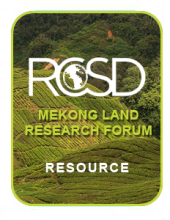Land Library
Bienvenue dans la bibliothèque du Land Portal. Explorez notre vaste collection de ressources en libre accès (plus de 74 000), comprenant des rapports, des articles scientifiques, des articles de recherche, des publications évaluées par des pairs, des documents juridiques, des vidéos et bien plus encore.
/ library resources
Showing items 100 through 108 of 1368.The purpose of the report is to provide documentary evidence of land disputes recorded throughout 2015. This evidence was gathered from articles on land disputes from local printed media, meetings with Land and Housing Right Network (LAHRiN) members, and through on-site data collection.
Poverty reduction has become a worldwide promise, yet the term itself has been commonly abused to legitimize development policies and projects with truly questionable impacts on the poor.
Cambodia has long had a difficult mix of resource wealth and weak land governance, a function of its legacy of enduring postwar conflict and neoliberal development policies of the 1990s.
Sudden and gradual land use changes can result in different socio-ecological systems, sometimes referred to as regime shifts. The Lao PDR (Laos) has been reported to show early signs of such regime shifts in land systems with potentially major socio-ecological implications.
Farm incomes in rural Vietnam are tightly constrained by very small farm sizes.
ABTRACTED FROM FIRST PARAGRAPH: Cambodia’s forests are vital components of the highly threatened Indo-Burma biodiversity hotspot.
In Cambodia, the interactions between large-scale land investment and land titling gathered particular momentum in 2012–13, when the government initiated an unprecedented upland land titling programme in an attempt to address land tenure insecurity where large-scale land investment overlaps with
Namati offers this brief in the hope that Myanmar’s national reforms and the implementation of the country’s new National Land Use Policy can grow from the lived experience of ordinary Myanmar citizens.
The Asia-Pacific region is a hotspot for forest landscape conflicts which are played out between local communities and outsiders such as government agencies and private companies.

